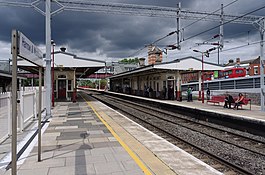Harrow & Wealdstone station
railway and London Underground station
Harrow & Wealdstone station is a station on the Bakerloo line. The Bakerloo line is on London Underground. The station opened for underground trains in 1917. It was closed for underground services 1982 but reopened in 1984. It is in travelcard zone 5, so it is near the edge of London. The next stop southbound is Kenton.
| Harrow & Wealdstone | |
|---|---|
 | |
| Location | Wealdstone |
| Local authority | London Borough of Harrow |
| Managed by | London Underground[1] |
| Owner | Network Rail |
| Station code | HRW |
| DfT category | C1 |
| Number of platforms | 6 |
| Accessible | Yes[2] |
| Fare zone | 5 |
| London Underground annual entry and exit | |
| 2017 | |
| 2018 | |
| 2019 | |
| 2020 | |
| 2021 | |
| National Rail annual entry and exit | |
| 2013–14 | |
| 2014–15 | |
| 2015–16 | |
| 2016–17 | |
| Key dates | |
| 1837 | Opened (L&BR) |
| 1890 | Opened Stanmore branch line (L&NwR) |
| 1917 | Started (Bakerloo line) |
| 1952 | Train crash |
| 1964 | Closed Stanmore branch line (BR) |
| 1982 | Ended (Bakerloo line) |
| 1984 | Restarted as terminus (Bakerloo line) |
| Listed status | |
| Listed feature | East side/bridge West side/platforms |
| Listing grade | II |
| Entry number | 1253982[9] 1253986[10] |
| Added to list | 6 September 1989 13 July 1990 |
| Other information | |
| External links | |
| WGS84 | 51°35′33″N 0°20′08″W / 51.5925°N 0.3355°W |

National Rail change
The station is served by London Overground, London Midland and Southern. On 8 October 1952, the station was the site of a train crash in which 112 people were killed.
Transport connections change
Bus routes 140 (24 hour), 182, 186, 258, 340, H9, H10 and night bus route N18 serve various stops beside or near the station. All the buses that serve the station also serve Harrow on the Hill station but not all as direct services.
References change
- ↑ "Safety boost as London Underground to take control of 11 Silverlink stations". Transport for London. 5 December 2006. Archived from the original on 13 December 2014. Retrieved 19 February 2015.
- ↑ "Step free Tube Guide" (PDF). Transport for London. March 2019. Archived (PDF) from the original on 1 June 2019.
- ↑ "Multi-year station entry-and-exit figures (2007–2017)". London Underground station passenger usage data. Transport for London. January 2018. Archived from the original (XLSX) on 31 July 2018. Retrieved 22 July 2018.
- ↑ "Station Usage Data" (CSV). Usage Statistics for London Stations, 2018. Transport for London. 21 August 2019. Archived from the original on 22 May 2020. Retrieved 27 April 2020.
- ↑ "Station Usage Data" (XLSX). Usage Statistics for London Stations, 2019. Transport for London. 23 September 2020. Archived from the original on 9 November 2020. Retrieved 9 November 2020.
- ↑ "Station Usage Data" (XLSX). Usage Statistics for London Stations, 2020. Transport for London. 16 April 2021. Retrieved 1 January 2022.
- ↑ "Station Usage Data" (XLSX). Usage Statistics for London Stations, 2021. Transport for London. 12 July 2022. Retrieved 7 September 2022.
- ↑ 8.0 8.1 8.2 8.3 "Station usage estimates". Rail statistics. Office of Rail Regulation. Please note: Some methodology may vary year on year.
- ↑ Historic England. "Details from listed building database (1253982)". National Heritage List for England (NHLE). Retrieved 14 November 2012.
- ↑ Historic England. "Details from listed building database (1253986)". National Heritage List for England (NHLE). Retrieved 14 November 2012.
Other websites change
Wikimedia Commons has media related to Harrow & Wealdstone station.
- London's Transport Museum Photographic Archive Archived 2012-02-14 at the Wayback Machine
- Europe's history of rail disasters (BBC)
- Harrow and Wealdstone Disaster
- Train times and station information Archived 2011-09-08 at the Wayback Machine for Harrow and Wealdstone railway station from National Rail (Station code: HRW)
